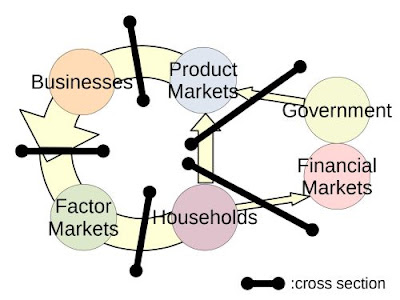In a previous article, 'A three-piece set for understanding the money circulation', we explain a quantitative view of the money circulation via our 3-piece set, the circular flow diagram, a definition of nominal GDP, and the quantity equation (Fisher's equation of exchange).
In this article, we introduce an integration of definitions of GDP and an extension of the quantitative equation. These are logical consequences from the quantitative view of the money circulation. The contents of this article are as follows.
1. Integration of GDP definitions
Our conclusion is that different definitions of GDP are different cross sections in the money circulation.
As is shown in the previous article, by integrating the 3-piece set, it is found that a definition of GDP (Y=C+G+I=C+S+T) means two cross sections in the money circulation.
There are other definitions of GDP. They are known as the production aspect, the income aspect, and the speculated expenditure aspect (=C+G+I). These are also cross sections in the money circulation.
When we found this relation at first, we compared multiple definitions of GDP with the circular flow diagram for integrating our 3-piece set. The following figure shows the relation between definitions of GDP and the circular flow diagram.
 |
| Cross sections in the circular flow diagram. |
Hereinafter, government and financial markets are called as "outside". In the above figure, a GDP definition, Y=C+T+S, means a cross section from households to product markets and outside. And another GDP definition, Y=C+I+G, means a cross section from households and outside to product markets.
For other definitions of GDP, the production aspect means a cross section from product market to businesses. The income aspect of GDP means a cross section between factor markets to households.
Once recognizing this integration, this integration is natural. The circular flow diagram indicates flows of money, goods and services, and labor power. Magnitudes of these flows are connected by equality. Different cross sections in the money circulation shows different aspects of money flow.
2. Extension of the quantity equation
Our conclusion is that, from the integration of the GDP definitions, we can extend the quantity equation.
The original quantity equation (Fisher's equation of exchange) is MV=PQ. This is a combination of the total amount of money that has passed through the product (goods and services) market and the total amount of products sold by businesses. Given the one-year measurement period, these amounts are nominal GDP.
According to the integration of the definitions of GDP, it is possible to connect amounts of money in other aspects to the quantity equation. We suggest an extension of the quantity equation, as follows.
 |
| An extension of the quantity equation. |
Here, NO is the total income of all households, and N'PS is the total amount of goods and services consumed and received by all consumers. In these products, N is the total number of households, O is the average income, N' is the total number of consumers, P is the average price, and S is the total number of goods and services consumed and received by one consumer.
People can easily accept the total income of households, NO. This is because it is the income aspect of GDP. Next, N'PS is the total amount of goods and services consumed and received by consumers. Note that here `to receive goods and services' means public services that do not require direct payment of money. For example, these are public education, peace and order, foreign diplomacy, progress of science, and others.
This N' is not the total number of households, but is that of consumers. Therefore, this N' is equal to the population. By adopting the total number of consumers here, we can discuss the production capacity of one worker (household) for the total number of goods and services for a consumer, via NO=N'PS.
We cannot assure readers that our extension of the quantitative equation can cover the whole of the money circulation. This is an open question.
Our original article, `【貨幣循環】名目GDPの定義の統合と拡張された数量方程式`
Link page: Contents for money circulation




No comments:
Post a Comment